US headline durable goods orders rose 2.7% to USD 258.5B in March, much stronger than expectation of 0.7%. Ex-trans orders rose 0.4%, also better than expectation of 0.2% . Ex-defense orders rose 2.3%. Transportation equipment rose 7.0% to USD 93.8B.
US initial claims rose to 23k, down trend broken
US initial jobless claims rose 37k to 230k in the weekending April 20, well above expectation of 199k. Four-week moving average of initial claims rose 4.5k to 206k. More importantly, it appears the down trend since January is broken.
Continuing claims rose 1k to 1.655m in the week ending April 13. Four-week moving average of continuing claims dropped -25k to 1.688m.
ECB: Eurozone trade regained some momentum but may be short-lived
In the latest monthly bulletin, ECB reiterated that recent data confirms “slower growth momentum extending into the current year”. And, “global headwinds continue to weigh on euro area growth developments”. Risks remain “tilted to the downside”, ” on account of the persistence of uncertainties related to geopolitical factors, the threat of protectionism and vulnerabilities in emerging markets.” “Ample degree of monetary accommodations remains necessary”.
On Eurozone growth, ECB noted that the slowdown in has continued, as incoming data have overall been weaker than expected in the first quarter of 2019. Consumer spending continued to rise, albeit at a lower growth rate than in previous years. However, labour markets remain robust, despite some slowdown. Also, recent short-term labour market indicators continue to point to positive but moderating employment growth in the first quarter of 2019. Private consumption is expected to continue to rise at robust rates.
ECB also noted that and short-term indicators point to a possible further slowdown in business investment. in the first quarter of 2019. Trade regained some momentum at the start of 2019 but according to leading indicators it may be short-lived. Overall, the latest economic indicators suggest a sizeable moderation in the pace of economic expansion. This moderation reflects in part a slowdown in external demand, compounded by some country and sector-specific factors.
UK retail sales grew gain in April, but Brexit uncertainty continues to drag on consumer confidence
UK CBI trends total orders rose to 13 in April, up fro -18 and beat expectation of 0. 49% of retail sales said sales volumes were up in April from a year ago. 36% said they were down, giving a balance of 13%. It’s the first time retail sales grew since November 2018.
Rain Newton-Smith, CBI Chief Economist, said: “It’s encouraging to see retailers with more of a spring in their step than in recent months. The recent pick up in real wages is a welcome support to the sector, making the pound in people’s pockets stretch that bit further. However, this month’s sales growth will have been distorted by the later timing of Easter, and falling sales in clothing and department stores underline how challenging underlying conditions remain
Also: “The Brexit extension means an economic crisis has been avoided, for now. However, uncertainty continues to drag on consumer confidence, and many retailers report an impact on their sales. Politicians now owe it to the country – its businesses and people – to come together in a total spirit of compromise, setting aside all party political lines, and agree a way forward to avoid a no deal Brexit.”
UK May requested to lay out timetable to leave if no Brexit deal is approved
In UK, it’s reported that Conservative backbench 1922 Committee rejected a proposal for chance in party rules to allow an early vote of no confidence in Prime Minister Theresa May. However, Committee chairman Graham Brady also requested May to set out a timetable for her departure in the event of a Brexit deal not being passed. This is on top of May’s promise that she would go after the Brexit deal is passed.
Separately, Cabinet Minister David Lidington, said that the government wants to get the thrice-defeated Brexit deal through the parliament before the new European Union parliament opens in July. But the timing will depend on negotiation with the opposition Labour Party. Meanwhile, Commons Leader Andrea Leadsom announced the business for next week. No items regarding Brexit is included.
NIESR expects no BoE hike until August 2020
UK National Institute of Economic and Social Research (NIESR) pushed back their BoE rate expectation by a year in the new forecasts. NIESR economist Garry Young said “now we expect the first increase in Bank Rate to be next August rather than this August.”
NIESR also noted that Brexit related uncertainty “has led to investment plans being deferred and increased stockbuilding.” Under the main scenario of “soft Brexit”, GDP growth will continue at around 1.5% in both 2019 and 2020. Unemployment rate will stay at around 4%. CPI will remain at around 2%.
Regarding different Brexit scenarios, growth will be similar between staying in EU and “soft Brexit”. However, growth will be weaker is UK is to stay in the customs union, and even worse in a no-deal Brexit.
“Prospects for the UK Economy” details.
BoJ pledges to keep interest rates low at least through Spring 2020
BoJ left monetary policy unchanged today as widely expected. More importantly, the central bank now provides much clearer forward guidance. It’s noted that “the Bank intends to maintain the current extremely low levels of short- and long-term interest rates for an extended period of time, at least through around Spring 2020”. That’s based on “uncertainties regarding economic activity and prices including developments in overseas economies and the effects of the scheduled consumption tax hike.”
Under the yield curve control framework, short term interest rate is kept at -0.1%. BoJ will continue to purchase JGBs to keep 10-year yield at around 0%, with some flexibility. Annual pace of monetary base expansion is kept at JPY 80T. Y Harada dissented again, proposing to tie forward guidance to price stability target. G Kataoka also dissented too, urging BOJ to commit to take additional easing measures if there is downward revision in medium- to long-term inflation expectations. The vote was by 7-2.
On the economy, BoJ said it’s likely to “continue on a moderate expanding trend” despite the impact from overseas slowdown. CPI continued to show “relatively weak developments”, comparing to labor market tightening. But it expects CPI to “gradually” increase towards 2% target. Though, there are “high uncertainties regarding the outlook for economic activity and prices
including developments in overseas economies”.
Asian update: Dollar surge on “safe haven” flows, breaks key resistance
Dollar and Yen are overwhelmingly the strongest ones for the week. The steep declines in bond yields indicate clear “safe haven” flows. In particular, German 10-year bund yield turned negative again. US 10-year yield (TNX) also dived notably by -0.048 to 2.522. TNX was on a verge of reclaiming 2.6 handle just days ago.
However, risk aversion is not apparent in the stock markets yet. DOW, S&P 500 and NASDAQ just closed slightly lower overnight, with the latter two being close to record highs. Major Asian markets are just mixed and showed no response. The greenback was shot higher against after strong US corporate earnings, including Facebook, Microsoft and Visa. But Asian stocks shrugged.
In Asia, currently:
- Nikkei is up 0.52%.
- Hong Kong HSI is down -0.01%.
- China Shanghai SSE is down -0.93%.
- Singapore Strait Times is down -0.18%.
- Japan 10-year JGB yield is up 0.0076 at -0.028.
Overnight:
- DOW dropped -0.22%.
- S&P 500 dropped -0.22%.
- NASDAQ dropped -0.23%.
- 10-year yield dropped -0.0048 to 2.522.
Technically, EUR/USD’s break of 1.1176 support yesterday is worth a mention. The down trend from 1.2555 (2018 high) should be resuming. Medium term bearish is also maintained with EUR/USD staying well below 55 week EMA. Next medium term target will be 78.6% retracement of 1.0339 to 1.2555 at 1.0813.
CHF and JPY firmer as German 10-yr yield turns negative, US 10-yr yield dives
Swiss Franc and Yen are both strong today, helped by decline in treasury yields. At the time of writing, German 10-year bund yield is down -0.0555 at -0.011. It turned negative for the first time since April 12.
US 10-yer yield is down -0.050 at 2.520. More importantly, today’s sharp fall suggests that TNX is rejected by 55 day EMA, as well as long term channel support turned resistance. Focus would be back on 2.463 support for the near term. Strong support from this level will retain near term bullish, for at least another rebound to 2.759 resistance. However, decisive break of 2.463 will likely resume larger decline from 3.248 through 2.356 low.
BoC drops tightening bias, Canadian Dollar dives
Canadian Dollar dives sharply after BoC kept overnight rate unchanged at 1.75% and drops tightening bias. The accompanying statement concluded by saying that ” an accommodative policy interest rate continues to be warranted”. The “appropriate degree” of accommodation will be evaluated as new data come in . In particular, BoC will monitor “developments in household spending, oil markets, and global trade policy”. The sentence regarding ” future rate increases” was omitted.
Growth forecasts for 2019 was sharply revised lower to 1.2%, down from January projection of 1.7%. 2020 growth forecast was revised slightly lower from 2.1% to 2.0%. Inflation is expected to remain around 2% through 2020 and 2021.
Full statement below.
Bank of Canada maintains overnight rate target at 1 ¾ per cent
The Bank of Canada today maintained its target for the overnight rate at 1 ¾ per cent. The Bank Rate is correspondingly 2 per cent and the deposit rate is 1 ½ per cent.
Global economic growth has slowed by more than the Bank forecast in its January Monetary Policy Report (MPR). Ongoing uncertainty related to trade conflicts has undermined business sentiment and activity, contributing to a synchronous slowdown across many countries. In response, many central banks have signalled a slower pace of monetary policy normalization. Financial conditions and market sentiment have improved as a result, pushing up prices for oil and other commodities.
Global economic activity is expected to pick up during 2019 and average 3 ¼ per cent over the projection period, supported by accommodative financial conditions and as a number of temporary factors weighing on growth fade. This is roughly in line with the global economy’s potential and a modest downgrade to the Bank’s January projection.
In Canada, growth during the first half of 2019 is now expected to be slower than was anticipated in January. Last year’s oil price decline and ongoing transportation constraints have curbed investment and exports in the energy sector. Investment and exports outside the energy sector, meanwhile, have been negatively affected by trade policy uncertainty and the global slowdown. Weaker-than-anticipated housing and consumption also contributed to slower growth.
The Bank expects growth to pick up, starting in the second quarter of this year. Housing activity is expected to stabilize given continued population gains, the fading effects of past housing policy changes, and improved global financial conditions. Consumption will be underpinned by strong growth in employment income. Outside of the oil and gas sector, investment will be supported by high rates of capacity utilization and exports will expand with strengthening global demand. Meanwhile, the contribution to growth from government spending has been revised down in light of Ontario’s new budget.
Overall, the Bank projects real GDP growth of 1.2 per cent in 2019 and around 2 per cent in 2020 and 2021. This forecast implies a modest widening of the output gap, which will be absorbed over the projection period.
CPI and measures of core inflation are all close to 2 per cent. CPI inflation will likely dip in the third quarter, largely because of the dynamics of gasoline prices, before returning to about 2 per cent by year end. Taking into account the effects of the new carbon pollution charge, as well as modest excess capacity, the Bank expects inflation to remain around 2 per cent through 2020 and 2021.
Given all of these developments, Governing Council judges that an accommodative policy interest rate continues to be warranted. We will continue to evaluate the appropriate degree of monetary policy accommodation as new data arrive. In particular, we are monitoring developments in household spending, oil markets, and global trade policy to gauge the extent to which the factors weighing on growth and the inflation outlook are dissipating.
Information note
The next scheduled date for announcing the overnight rate target is May 29, 2019. The next full update of the Bank’s outlook for the economy and inflation, including risks to the projection, will be published in the MPR on July 10, 2019.
Japan Abe, Aso and Motegi to visit US on trade and currencies
Japanese Deputy Prime Minister and Finance Minister Taro Aso, and Economic and Fiscal policy minister Toshimitsu Motegi, economic and fiscal policy minister, will visit Washing on Thursday.
Aso will meet US Treasury Secretary Steven Mnuchin and currency issues are believed to be the major focuses. Mnuchin said before that the US would likely include a provision regarding currency manipulation in any upcoming trade agreement with Japan. But it’s facing strong resistance.
Motegi will meet Trade Representative Robert Lighthizer for trade negotiation. There was virtually no progress in the trade talks so far, other than exchanging views. The US highlighted a large deficit with Japan during prior meeting, much of it from auto exports. But there is no response from Japan so far.
Prime Minister Shinzo Abe will travel to Washington on April 26-27. Then the top Japanese officials will travel back to Japan on Tuesday for a series of rites related to the day’s abdication of Emperor Akihito.
Into US session: CHF strongest, AUD weakest, CAD awaits BoC
Entering into US session, commodity currencies are the weakest ones for today. Australian Dollar leads the decline as much weaker than expected CPI raises the chance of an RBA rate cut in second half. New Zealand Dollar follows as second as RBNZ could cut even earlier in May. Canadian Dollar is the third weakest against of BoC rate decision. BoC is widely expected to keep interest rate unchanged at 1.75% today. It’s not totally sure if BoC would drop tightening bias today. If not, there is prospect of a rebound in the loonie.
On the other hand, Swiss Franc is the strongest one, reversing some of recent losses. Technical resistance in EUR/CHF is a factor helping the Franc. Also, German 10-year yield drops notably today, threatening to turn negative again. Sterling is the second strongest, followed by Yen. Dollar is mixed for now. While US stocks jump sharply yesterday with S&P 500 and NASDAQ making new record closes, upside momentum isn’t too convincing today. Euro is also mixed even though Ifo business climate reversed some of March’s gains and declined to 99.2 in April.
In Europe, currently:
- FTSE is down -0.50%.
- DAX is up 0.64%.
- CAC is down -0.28%.
- German 10-year yield is down -0.0374 at 0.007.
Earlier in Asia:
- Nikkei dropped -0.27%.
- Hong Kong HSI dropped -0.53%.
- China Shanghai SSE rose 0.09%.
- Singapore Strait Times rose 0.27%.
- Japan 10-year JGB yield dropped -0.0052 to -0.035.
ECB: Impact of trade tensions escalation could heighten financial stress and lower confidence
In a paper released today, ECB noted that last year’s increased in trade tensions and the repercussions of the tariffs implemented pose only a “modest adverse risk” to the global and euro area outlooks. Also, impact of implemented tariffs and tariff announcements owing to uncertainty effects appears to have remained “confined to the targeted sectors” for the time being.
However, if trade tensions were to escalate once again, “the impact would be larger”. Model-based simulations indicate that the medium-term direct impact of an escalation could be “sizeable, compounded by heightened financial stress and a drop in confidence.” The longer-term effects would be “even more pronounced”.
ECB also warned that “although free trade is often seen as one of the factors behind rising inequality both within and across countries, winding back globalisation is the wrong way to address these negative effects.” “A retreat from openness will only fuel more inequality, depriving people of the undisputed economic advantages that trade and integration bring.”. The paper urged that “countries should seek to resolve any trade disputes in multilateral fora”.
Full paper “The economic implications of rising protectionism: a euro area and global perspective“.
German Ifo dropped to 99.2, March’s gentle optimism evaporated
German Ifo Business Climate Index dropped to 99.2 in April, down from 99.7 and missed expectation of 99.9. Expectation Index dropped to 95.2, down fro 95.6 and missed consensus of 96.0. Current Assessment Index also dropped to 103.3, down from 103.8 and missed expectation of 103.6.
Ifo President Clemens Fuest noted that “the mood among German managers became slightly gloomier this month… March’s gentle optimism regarding the coming months has evaporated. The German economy continues to lose steam.” Ifo economist Klaus Wohlrabe said the data points to 0.8% growth in Germany this year.
Looking at the details, business climate in manufacturing “has again worsened markedly”, down from 6.7 to 4.0. It’s the eighth straight month of decline. Services continued recovery from 26.1 to 26.3, comparing to cyclic low at 21.5 in February. Trade worsened again from 8.2 to 7.1. Construction improved slightly from 20.4 to 21.4.
BoC to drop tightening bias, or would it?
BoC is widely expected to keep overnight rate unchanged at 1.75% today. Back in March, the central bank has already shifted to a more cautious stance and noted outlook “warrant a policy interest rate that is below its neutral range”. Also, given the mixed picture ” it will take time to gauge the persistence of below-potential growth and the implications for the inflation outlook.” But after all, tightening bias was maintained and there was just “increased uncertainty about the timing of future rate increases.”
Since then, data have been mixed. Headline CPI rose to 1.9% yoy in March, sharply higher than February’s 1.5% yoy. Core CPI also picked up slightly from 1.5% yoy to 1.6% yoy. Median CPI rose to 2.0% while trimmed mean CPI rose to 2.1% yoy. Job data remained resilient too. However, BoC’s Business Outlook Survey (BOS) disappointed with the overall business index falling to -0.6% in 1Q19. The result pointed to “a moderation from previously high levels of domestic and foreign demand for firms in most regions”.
There are speculations that BoC could totally drop tightening bias, and indicate that rates will stay there for longer. However, the recent data might not be giving enough pressure for BoC to do it. Also, oil price has been in strong rally since WTI bottomed at 42.05 last December. The current picture, with WTI back above 65, is drastically different from that one in January. Thus, the anticipated neutral shift is far from being certain. BoC will also release new economic projections. Today’s announcement is a wild card.
Some suggested readings:
- BoC Meeting: Cautious, But Less Than Markets Expect
- BOC to Look Through Strong March Inflation and Maintain Dovish Stance
- Forward Guidance: Bank of Canada Will Officially Shift to a Neutral Bias Next Week
Big downside surprise in Australia CPI adds to case for RBA cut, AUD dives
Australian Dollar is sold off sharply after much weaker than expected consumer inflation data.
- Headline CPI rose 0.0% qoq, 1.3% yoy in Q1, down from 0.5% qoq, 1.8% yoy, missed expectation of 0.2% qoq, 1.5% yoy. The 1.3% annual rate is also the slowest since September 2016.
- RBA trimmed mean CPI rose 0.3% qoq, 1.6% yoy, below expectation of 0.4% qoq, 1.7% yoy. Annual rate is slowest since December 2016.
- RBA weighted median CPI rose 0.1% qoq, 1.2% yoy, well below expectation of 0.4% qoq, 1.6% yoy.
The weak inflation data heighten the prospect of RBA rate cut in May, together with RBNZ. But for now, it still seems a bit early for RBA to act given relative resilience in job data. May is more an ideal occasion for RBA to turn dovish with new economic projections and SoMP. If it happens, the case for a cut in August would be secured.
AUD/USD’s steep decline and acceleration through 0.7052 support confirms that corrective recovery from 0.7003 has completed with three waves up to 0.7205. Decline from 0.7295 should be ready to resume through 0.7003 support, towards 0.6722 low.
EUR/AUD’s strong rally also suggests that corrective fall from 1.6765 has completed with three waves down to 1.5683, well ahead of 1.5346 key support. Further rise should be seen to 1.6122 resistance next. Break will pave the way back to 1.6765.
AUD/JPY’s rebound from 70.27 was relatively stronger than AUD/USD. But even so, it was limited well below 83.90 key resistance. Thus, it’s more likely that such rebound is merely a correction. Today’s sharp decline is raising the prospect that it’s already completed. We’d expect deeper fall to retest 77.44 support first. Decisive break there will revive medium term bearish outlook for 70.27 low.
S&P 500 and NASDAQ closed at records, no follow through in Asia
US stocks enjoyed strong rally overnight as boosted by solid corporate earnings from Coca-Cola to Twitter. S&P 500 and NASDAQ closed at records of 2933.68 (up 0.88%) and 8120.82 (up 1.32%) respectively. Though, they’re both held below intraday highs. DOW also gained 0.55% to 26656.39.
Technically, the strong momentum suggests that both S&P 500 and NASDAQ will easily take out intraday records at 2490.91 and 8133.30. That could likely pull DOW upward to equivalent level at 26951.81. Yet, we’re still not too convinced that the indices are in long term up trend resumption yet.
Two developments give us some doubts over the underlying momentum of the global markets. Firstly, Asian markets are not following and with major indices, except Singapore Strait Times, turned red after initial gains today. Secondly, Yen is the strongest one for the week so far while USD/JPY is stuck in tight range only, which isn’t the usually development seen in strong risk on market. Thus, there will be a lot of caution in the next move up.
Anyway, for now, near term outlook in SPX will release bullish as long as 2891.90 support holds. Firm break of 2490.91 should at least bring a test on 3000 psychological level.
Similarly, near term outlook in NASDAQ will remain bullish as long as 7950.97 support holds. Firm break of 8133.30 will confirm long term up trend resumption.
US-China trade talks to resume in Beijing on Apr 30, Kudlow said cautiously optimistic but not there yet
The White House announced that Trade Representative Robert Lighthizer and Treasury Secretary Steven Mnuchin will travel to Beijing to on April 30 to continue trade talks. China’s team will again be led by Vice Premier Liu He. Liu is expected to fly to Washington on May 8 for additional discussions. In the statement, it’s noted that “the subjects of next week’s discussions will cover trade issues including intellectual property, forced technology transfer, non-tariff barriers, agriculture, services, purchases, and enforcement.”
Earlier yesterday, Larry Kudlow, Director of the White House National Economic Council, said the negotiations were making progress and he was “cautiously optimistic” on striking a deal. He hailed that “we’ve come further and deeper, broader, larger-scale than anything in the history of U.S.-China trade.”
But Kudlow also noted that “We’re not there yet”. “We’re still working on the issues, so-called structural issues, technology transfers”. Also, “ownership enforcement is absolutely crucial. Lowering barriers to buy and sell agriculture and industrial commodities. It’s all on the table.”




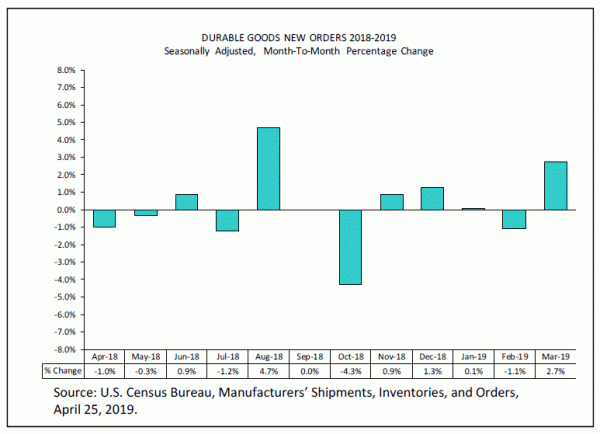
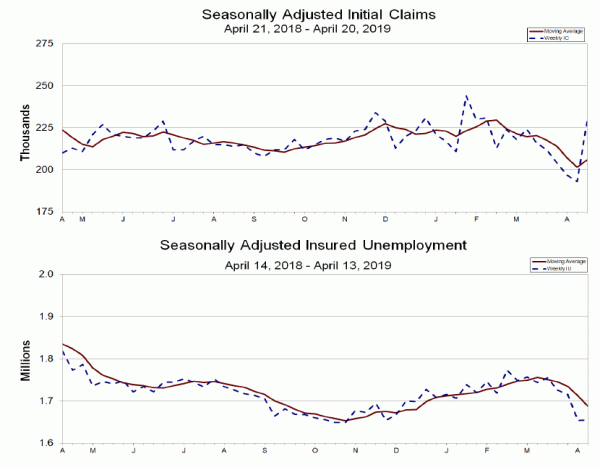
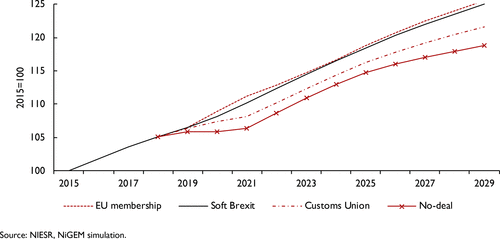
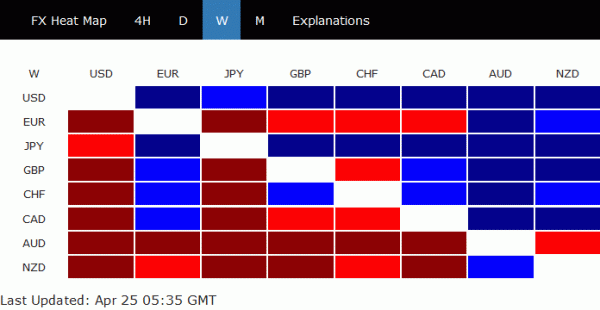
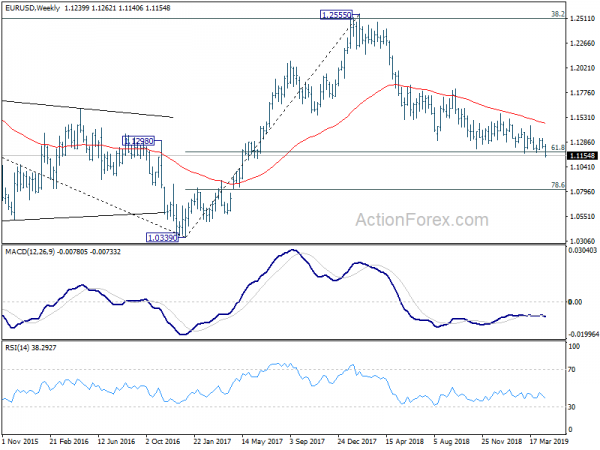
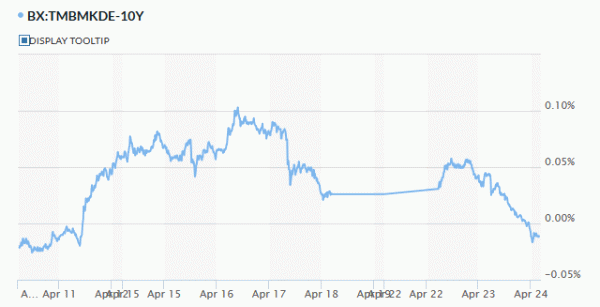
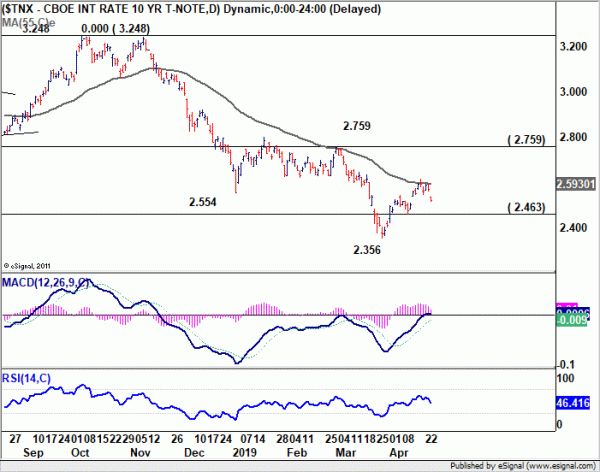
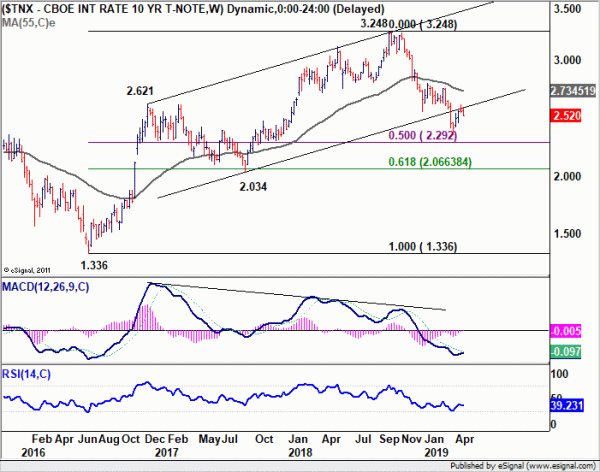

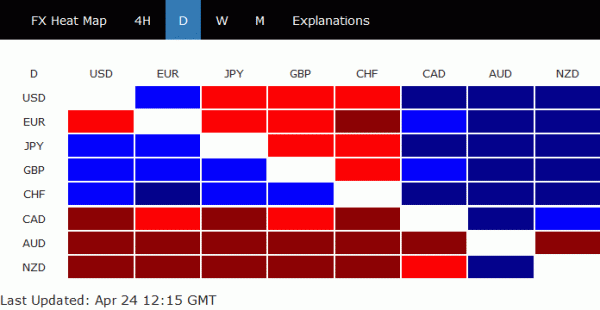
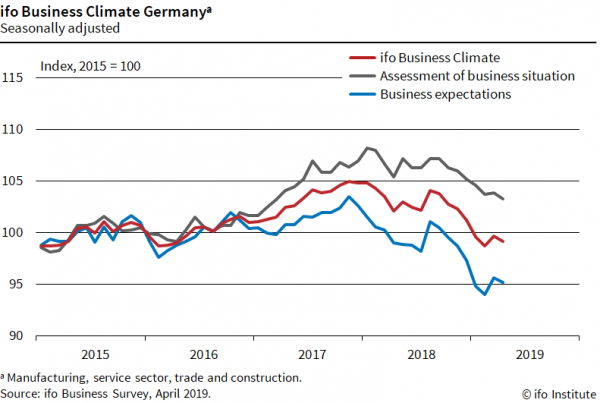
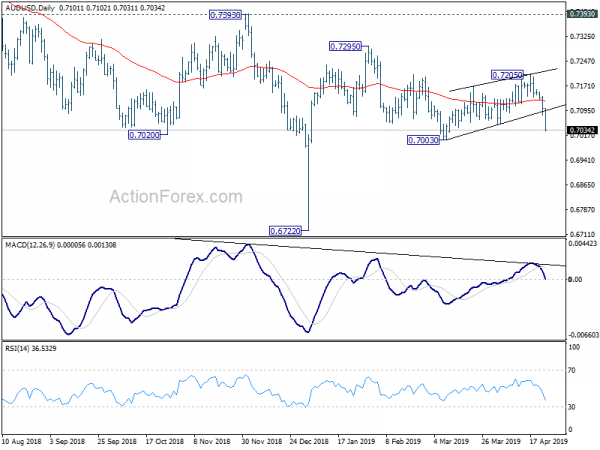
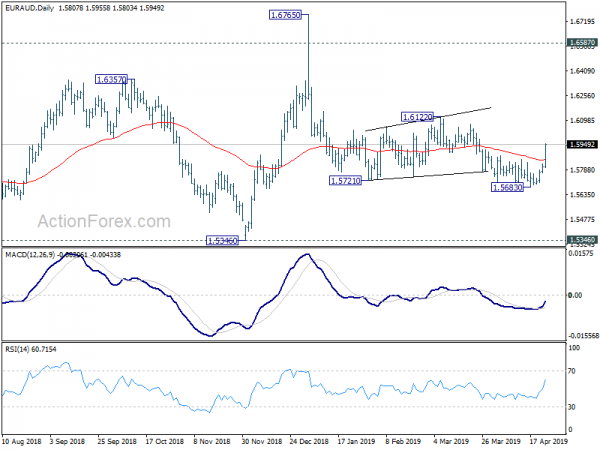
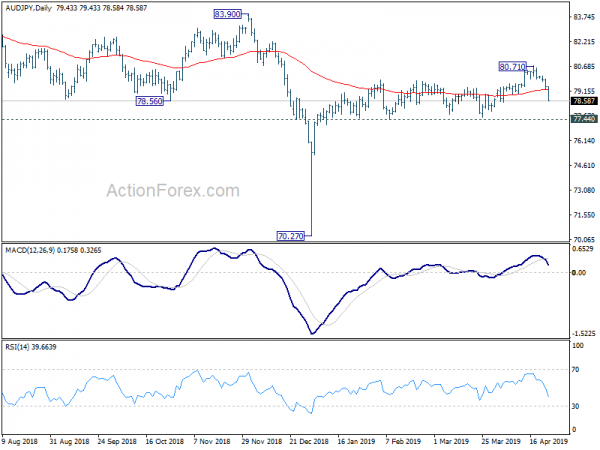
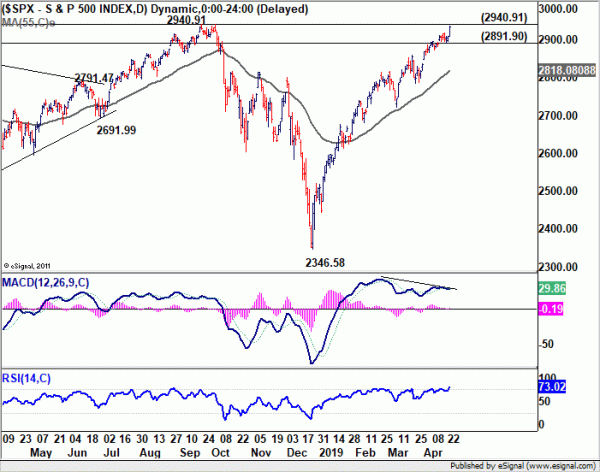
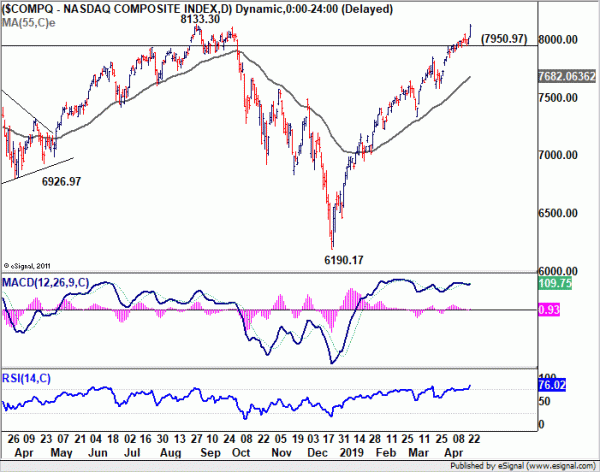


US update: Yen surges as stocks tumble on 3M warning, DOW risking near term reversal
Yen surges broadly while Dollar is under some pressure as US stocks are in steep selloff. Industrial giant 3M is the key driver in the markets as it slashed 2019 full-year guidance and announce 2000 job cuts. It’s more than enough to offset the lift by Microsoft, which reported healthy quarterly results yesterday.
At the time of writing, DOW is already down -253 pts, or 0.95%. S&P 500 is down -0.40%. NASDAQ made new record high at 8151.84 but quickly retreated and is down -0.27%.
DOW has been the under performer comparing with the other two major indices. With today’s gap down, focus will be on 26070.83. Break will be the first sign that rise from 21712.53 has completed, ahead of 26951.81 record high, on bearish divergence condition in daily MACD. Deeper fall should then be seen, at least, to 38.2% retracement of 21712.53 to 26695.96 at 24792.29. Such development would drag down USD/JPY, as well as other Yen crosses. But we wouldn’t expect it to prompt deep selling in Dollar elsewhere.